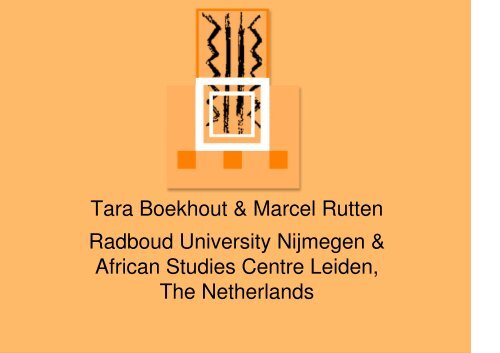Tara Boekhout & Marcel Rutten Radboud University ... - IUCN
Tara Boekhout & Marcel Rutten Radboud University ... - IUCN
Tara Boekhout & Marcel Rutten Radboud University ... - IUCN
Create successful ePaper yourself
Turn your PDF publications into a flip-book with our unique Google optimized e-Paper software.
<strong>Tara</strong> <strong>Boekhout</strong> & <strong>Marcel</strong> <strong>Rutten</strong><br />
<strong>Radboud</strong> <strong>University</strong> Nijmegen &<br />
African Studies Centre Leiden,<br />
The Netherlands
Slum upgrading 2.0<br />
Effect of relocating Nairobi slum dwellers into a new<br />
settlement in its semi-rural hinterland
Introduction<br />
Nairobi: uncontrolled growth of informal settlements<br />
• Traditional slum upgrading focus on physical<br />
infrastructure<br />
Jamii Bora: microfinance and social programmes<br />
• Decent housing critical to get people out of<br />
vicious cylce of poverty
Research Design<br />
• Research objective: Get insight in the effect of Jamii Bora’s slum<br />
resettlement project on Kisaju area, Kajiado district, Kenya, with<br />
special attention to natural resources.<br />
• CoCooN hypotheses:<br />
1. Increased diversification of household economies leads to intensified<br />
occurrence of conflicts<br />
2. Sudden changes in resource availability cause conflicts<br />
3. The absence of (effective) institutions allows for more conflicts over natural<br />
resources<br />
Fieldwork July-September 2011<br />
• 150 questionnaires: 75 New Kaputiei Town households and 75 neighbouring<br />
community households<br />
• 32 interview with key informants:<br />
- 4 Jamii Bora management representatives & 8 New Kaputiei Town residents<br />
- 6 Government officials & 4 NGO’s or persons involved in court case<br />
- 10 Local representatives (3 Maasai village elders, 7 local community members)
New Kaputiei Town
Project plan New Kaputiei Town<br />
Mission: Providing quality low cost housing to slum<br />
dwellers in a sustainable socio-economic environment<br />
Model for socially and ecologically sound low<br />
income housing development in Kenya<br />
• 2,000 units for each Ksh 350,000 (€3200)<br />
• 10,000 slum dwellers
Resistance<br />
Maasai community Kisaju<br />
• Environemental concerns<br />
• Security, Politics, Livelihood and Culture<br />
Memorandum of Understanding<br />
Wildlife conservation community and NGO’s<br />
• Nairobi National Park dispersal area<br />
• Wildlife migratory corridor<br />
Court Case
Natural resources in Kisaju (1)<br />
Water resources:<br />
• Boreholes main water resource<br />
• Availability: human consumption and economic activities<br />
• Quality: high fluoride content level<br />
• Conflict over water resources<br />
Grazing land:<br />
• Availability: changes in land rights and land use<br />
• Quality: depletion of water resources and expansion of Nairobi<br />
• Conflict over grazing land
Quality of grazing land<br />
Table 1. Reasons for the negative trend of quality of pasture<br />
1 Longer dry seasons 98.5<br />
2 Less rainfall 96.9<br />
3 Urbanization 96.9<br />
4 Less flooding of river/drying of water sources 89.2<br />
5 New (fenced) activities 86.2<br />
6 More shambas encroaching on pasture 75.4<br />
7 Higher temperatures 73.8<br />
8 More wildlife competing over grass 69.2<br />
9 Lack of finances to buy/lease pasture 60.0<br />
10 More animals (overgrazing – erosion)) 56.3<br />
11 Salinization of groundwater 24.2<br />
12 Salty water flooding 21.0<br />
13 (Bad) invading plant species 15.0<br />
14 Less animals (undergrazing – shrub/bush) 10.8<br />
Source: Fieldwork 2011<br />
%
Natural resources in Kisaju (1)<br />
Water resources:<br />
• Boreholes main water resource<br />
• Availability: human consumption and economic activities<br />
• Quality: high fluoride content level<br />
• Conflict over water resources<br />
Grazing land:<br />
• Availability: changes in land rights and land use<br />
• Quality: depletion of water resources and expansion of Nairobi<br />
• Conflict over grazing land
Natural resources in Kisaju (2)<br />
• Diversification of household economies<br />
• Land Use Master Plan
Impact of New Kaputiei Town<br />
in Recourse Allocation<br />
• Water resources: provision and access versus<br />
increasing scarcity and pollution<br />
• Grazing land: reduction of availability and quality<br />
of pasture
Impact of New Kaputiei Town in<br />
Recourse Allocation<br />
• Water resources: provision and access versus<br />
increasing scarcity and pollution<br />
• Grazing land: reduction of availability and quality<br />
of pasture
Progress of the housing project<br />
Development of the facilities in New Kaputiei Town<br />
Mission to provide quality low-income housing to<br />
poor<br />
• Increase housing prices<br />
• Kisaju View Park Estate<br />
• Quality of the houses<br />
• Sustainable socio-economic environment
Progress of the housing project<br />
Development of New Kaputiei Town<br />
Mission: quality low-income housing for poor<br />
• Increased housing prices<br />
• Quality of the houses<br />
• Employment opportunities<br />
• Neighbouring community
Conclusions<br />
• Jamii Bora lost sight of mission<br />
• Increasing diversification of household<br />
economics<br />
• Sudden influx of people is causing tension<br />
• Lack of institutions managing natural<br />
resource

















